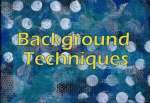Ive finally managed to sign up for my first swap of 2009!
This was for a mystery swap where initially we didnt know what we were all signing up for! All was finally revealed and we found out for the swap we had to make something following these fab instructions for polymer clay brocades which Ms Adrienne ‘bossy boots’ had uploaded and shared on her blog:
http://adriennegoodenough.blogspot.com/2009/05/polymer-clay-brocade.html
I finally got round to playing and making my bits for this swap last night and took a couple of photos along the way to share my experience!
Polymer Clay Brocade First Steps:
1. You have to roll out a piece of polymer clay onto a ceramic tile using a roller – I didnt have neither of these so instead I used chopped up pieces of a black bin liner to work on and I improvised using a gluestick as my rolling pin for the clay.
The clay I used was fimo soft and I was surprised just how soft it was to work with, as you know I am always moaning about the pains in my hands and I didnt have any real issues working with this clay – happy days!
2. Once you’ve rolled out the clay you paint it with a few layers of metalic paint, for this I used my lumieres paints in bronze, gold and pearl white and also my stewart gill bright gold as I love that colour! You only need a tiny bit of paint and you apply it with your fingers.
3. Next stage is to stamp into the clay, I didnt wait till the paint had dried as Im impatient, I inked my stamps with versamark so that they wouldnt get stuck into the clay and could be removed easily and it seemed to do the trick.
4. You need 3 different colours of acrylic paints for the next stage, basically you rub the colours onto the clay to add highlights to the raised unstamped areas, less is more. My clay was still wet from the previous paint layers and this seemed to help the highlighting colours to blend onto the clay more freely I found.
The colours I used mainly for this stage where blue, pink, turquiose,green, yellow and purple.
Heres some photos of what my clay brocades looked like at this point:






These 2 I did with Model Magic by Crayola just to see if it would work with air dry clay:


The instructions for this technique ask for black colour clay, I did use black but I also used some brown and some light blue clay I already had to see if you REALLY REALLY needed the black clay to make this technique work. As you can see from the photographs above, you DONT really need black clay because you cant really tell the difference once youve put all the layers of paint onto the clay.
Step 2:
Once youve painted, stamped and highlighted the clay you need to use cookie cutters or any type of cutters to make little shapes, I decided to go for geometric shapes with the intention of making mosiacs or something with them, heres a selection of the brocade shapes just prior to cooking them:

Step 3:
To cook my clay I used my melting pot! Ive had this gadget for probably about 5 years or more and up till now I have NEVER used it! First time out! To cook the fimo I put the heat setting on the melt pot to 110, waiting till it was hot enough, then evenly spaced the clay directly onto the pan of the melting pot, placed the lid on and walked off and left them to cook for half an hour. Came back and they were ready! I repeated this step till Id cooked all my pieces.
By the end of it all I had a few little pieces left which didnt quite fill the melting pot pan, so I placed them on the pan anyway and unplugged the melting pot and just left them on there till the melting pot had totally cooled down – when I came to put the melting pot away I realised the fimo had totally cooked itself on the pot as it was cooling off! So I didnt need to waste any more electricity cooking the small lil pieces I had left over!
Heres some photos of my finished clay brocades, Ive not uploaded my model magic ones yet because they arent dry yet!

Some Polymer Clay Brocade Close Ups:
































































